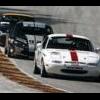August 12, 2015
Dear Spec Miata Stakeholders:
One of the projects the Mazda/NASA/SCCA Spec Miata Group embarked on was development and testing of potential changes to the 1.6L NA Spec Miata. The following is a summary of the project protocol, developed and approved collectively by the group and funded by Mazda for the overall improvement of the class.
Recognizing the unique challenges that the smaller engine provides to the balance of performance (BoP) of Spec Miata, the group developed the following protocol to evaluate performance modifications.
Methodology: SCCA oversaw testing on a DynoJet Chassis dyno at Jesse Prather Motorsports (JPM), in Topeka, Kansas, to compare each modification. JPM performed all performance modifications to the test vehicle. SCCA's Club Racing staff verified compliance and results.
Control components: All cars used had a leak down and compression check performed to ensure consistent bottom end performance. All cars had fresh fluids in the engine, transmission and differential. All cars used the same octane fuel. The cars used the same rolling wheel/tire combination and tire pressure.
A 1999 Mazda Miata in its current specification and restrictor was used as the baseline car. The baseline car was a representative example of a competitive Spec Miata optimized to the engine preparation rules and verified as compliant to the new (2015) cylinder head regulations. The testing protocol was as follows:
-Engine warmed to operating temperature.
-Car rolled the dyno for 3-5 minutes to warm drivetrain fluids.
-All dyno pulls were done in 4th gear.
-Pulls were made until the power curve dropped off (or stabilized over multiple pulls). The best run was saved as the baseline for that configuration.
1.6L NA Testing
-A crate motor was supplied by Mazda. The cylinder head from this engine was installed in the test car, utilizing a seasoned bottom end, along with the Springfield Dyno exhaust, adjustable fuel pressure regulator and a cone-style intake. Following the process described for the 1999 car, the 1.6L car was tested separately, but cumulatively, with the following modifications:
1.New crate motor head as supplied by Mazda (unmodified).
2.Configuration 1 plus permitted plunge cut and 1.5mm blending plus valve unshrouding
3.Configuration 2 plus a Jackson Racing header.
4.Configuration 3 plus adjustable cam gears.
5.Configuration 4 plus mill cylinder head to achieve a compression ratio as close to 10:1 as possible without risking valve interference.
6.Configuration 5 plus additional STR blending to 3mm.
-The tests were performed from Mid-February through late March, concluding on March 31.

The test data have been shared with the SCCA Spec Miata Advisory Committee (SMAC) and NASA. These data can be used for potential BoP adjustments. This is on the current SMAC agenda for its call August 19.
The Spec Miata Group is sharing this information for several reasons. First and foremost, the Group wants the process to be transparent to the community at-large. Second, we want the community to have the opportunity to provide the sanctioning bodies with input as the data are evaluated for potential changes. Finally, we found the data enlightening, and felt that you would as well.
To provide input to the rules-making bodies, please submit letters to www.crbscca.com for SCCA and/or johnmueller@drivenasa.com for NASA.
For the sport,
Eric Prill, SCCA Vice President and COO
John Doonan, Mazda Motorsports Director
John Mueller, NASA Spec Miata National Director
Jim Wheeler, SCCA Club Racing Board Chairman
John Bauer, SCCA Club Racing Technical Manager
David Cook, Mazda Motorsports Business Development Manager
Steve Sanders, MAZDASPEED Motorsports Development Manager
Mike Allen, MAZDASPEED Motorsports Development Specialist




 Sign In
Sign In Create Account
Create Account











 Back to top
Back to top Report
Report























